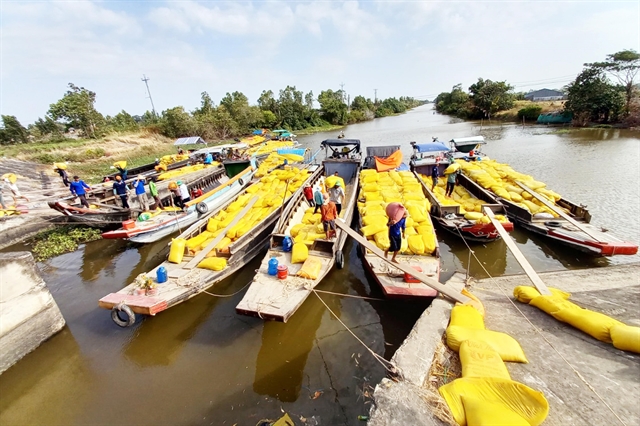 Society
Society

 |
| Traders buy paddy from the ongoing winter-spring crop harvest in Sóc Trăng Province’s Trần Đề District. – VNA/VNS Photo Tuấn Phi |
SÓC TRĂNG – The Cửu Long (Mekong) Delta province of Sóc Trăng plans to increase the cultivation of speciality rice varieties to improve farmers’ incomes.
It will develop 21 concentrated speciality rice farming areas by 2025 with cultivation and consumption stakeholders having linkages, 80 models that adapt to climate change and have similar linkages, and brand names for five co-operatives.
This year it hopes to produce two million tonnes of paddy, with high-quality and speciality varieties accounting for 92 per cent.
Trần Tấn Phương, deputy director of its Department of Agriculture and Rural Development, said to achieve the targets the province would develop speciality rice in nine localities – Ngã Năm Town, Sóc Trăng City and the districts of Trần Đề, Mỹ Xuyên, Thạnh Trị, Mỹ Tú, Châu Thành, Long Phú, and Kế Sách.
It would improve the operation of 50 co-operatives, including 20 that produce seeds, he said.
It would reduce cultivation of average- and low-quality varieties and increase that of fragrant speciality varieties, and grow the grain to organic and clean standards, he said.
It would apply advanced farming techniques, strengthen trade promotion and organise seminars on developing linkages between co-operatives, cooperative groups and rice processors, he added.
The department said last year farmers planted 332,700ha of rice and harvested more than two million tonnes, with high-quality and speciality varieties like ST24, ST25, Tài Nguyên, RVT, and Đài Thơm 8 accounting for almost 92 per cent.
The province has 21 concentrated speciality rice growing areas with a total area of 2,100ha.
More and more farmers use advanced techniques to grow the grain, thus increasing yields and reducing costs.
Lâm Anh Tài, who planted 1.5ha of the Đài Thơm 8 variety in the winter-spring crop in Châu Thành District’s Phú Tâm Commune, said he used a machine to sow seeds and used fewer seeds for sowing than traditional methods and this helped reduce the requirement by 50 per cent.
Traditionally, farmers sow a large number of seeds, which means the rice plants do not have enough space for full development, making yields low.
Tài got a yield of six tonnes per hectare.
The harvest of the crop is expected to be completed in March, according to the local Plant Protection and Cultivation Sub-department. – VNS




